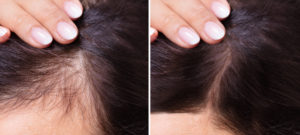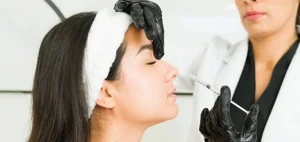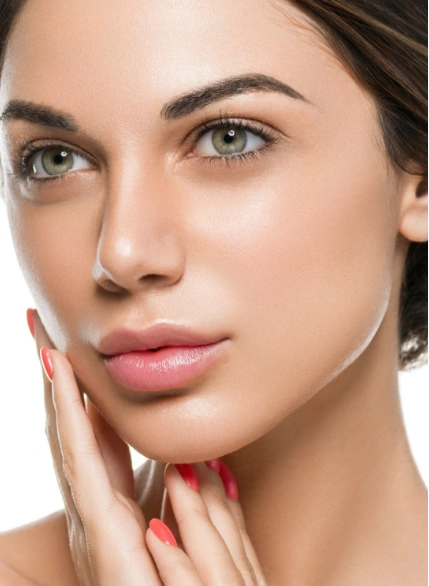Table of Contents
Chickenpox is such a common disease that everyone experiences it at least once in their lifetime – So if you’re someone who has already dealt with chickenpox in their childhood, or even in their adulthood; there are high chance that you have certain scars left on your body from chickenpox as a constant reminder.
These scars that are left behind by chickenpox are usually seen to fade over some time. However, at times for some people professional aesthetic treatments are required to remove them completely.
This blog will give you all the information you need regarding this type of scaring and detailed insight on removing chickenpox scars.
Types of Chickenpox Scars
There are two main types of chickenpox scars, as mentioned below:
-
Atrophic Scars
This type of scar is formed due to the damaged skin as well as the tissue, that is bound down or thinned out. Atrophic scars are known to permanently damage the skin once the wound is healed since the scar tissue structurally alters the standard skin.
-
Discoloration
Chickenpox scars can cause discolored indentations, often pink at an early stage or even whitish at a much later stage. These types of scars are visually similar to the scars from old acne.
What Causes Chickenpox Scars?
Chickenpox is a very discomfort-inducing disease that tends to cause blisters all over the entire body, along with an excruciating urge to itch. While it is strictly prohibited to scratch these blisters as they lead to scarring, it is almost impossible to not do that considering that it gets too severe.
The two major causes of chickenpox scars are:
- Damaged skin with deep wounds that are caused by excessively scratching the blisters
- Skin inflammation is another cause as it results in indented scars
Chickenpox Scar Removal Treatments
Listed below are the most popularly used cosmetic procedures that help in removing chickenpox scars in a highly effective manner:
-
Laser Therapy
Laser treatments for chickenpox scars are one of the most reliable methods available in reputed medspas such as Syra Aesthetics. In this procedure, the scar tissue is exposed to a medium or high-intensity energy beam. The dermatologists ensure that the intensity of the laser device is carefully controlled to avoid damaging the surrounding healthy skin tissue. The laser resurfacing treatment helps lighten the old scar’s color, improving its sunken appearance, and making it less visible. The upper layer of the skin is also removed by the laser, which further stimulates the growth of healthy skin.
How Much Does Laser Therapy Cost?
The cost of laser therapy varies depending on the size of the treatment area and the number of sessions needed. On average, it ranges from $500 to $2,000 per session.
-
Microneedling Radiofrequency
Microneedling is one of the safest treatments available for chickenpox scars. In this procedure, radiofrequency energy is deposited in the deeper layers of the skin through tiny needles which trigger collagen production. The scar begins to elevate with the induction of new collagen beneath the skin. This method is combined with other techniques like laser resurfacing for longer-lasting results.
How Much Does Microneedling Cost?
Microneedling costs typically range from $200 to $700 per session. Multiple sessions are usually recommended for optimal results.
-
Chemical Peeling Treatment
Chemical peels work by removing the surface layer of the skin, which may help to fade the color and depth of the scars. Some of the common agents used are alpha hydroxy acids, beta hydroxy acids, and a combination of both.
The benefits of chemical peels are:
- Chemical peeling is affordable
- It’s a safe, effective, and painless procedure
How Much Does Chemical Peeling Cost?
Chemical peels can cost between $150 to $600 per session, depending on the type and depth of the peel.
-
Surgical Procedures
For deep or stubborn scars, surgical procedures like punch excision or subcision may be necessary to physically remove scar tissue.
-
Fillers
Injectable fillers can temporarily fill in depressed scars, improving skin texture instantly.
How Much Do Fillers Cost?
The cost of fillers varies widely based on the type of filler used and the amount needed, ranging from $500 to $2,000 per treatment.
-
Dermabrasion and Microdermabrasion
Dermabrasion and microdermabrasion treatments mechanically exfoliate the skin, reducing scar visibility and promoting smoother skin texture.
-
Excision
Surgical excision involves cutting out the scar tissue and closing the wound with stitches, particularly effective for deep scars.
How Do Remove Deep Chicken Pox Scars Naturally?
While professional treatments are effective, natural remedies can complement them:
-
Vitamin E
Known for its healing properties, apply vitamin E oil to scars regularly.
-
Aloe vera
Soothes and moisturizes the skin, aiding in natural healing.
-
Cocoa butter
Helps hydrate, treat chickenpox scars, and soften scar tissue.
-
Rosehip oil
Rich in essential fatty acids, it promotes skin regeneration and reduces scars over time.
Which Cream Is Best For Chicken Pox Scars?
Look for creams containing ingredients like silicone, vitamin C, or retinoids, which can help improve and treat chicken pox scars over time.
Chicken Pox Scar Removal Before And After
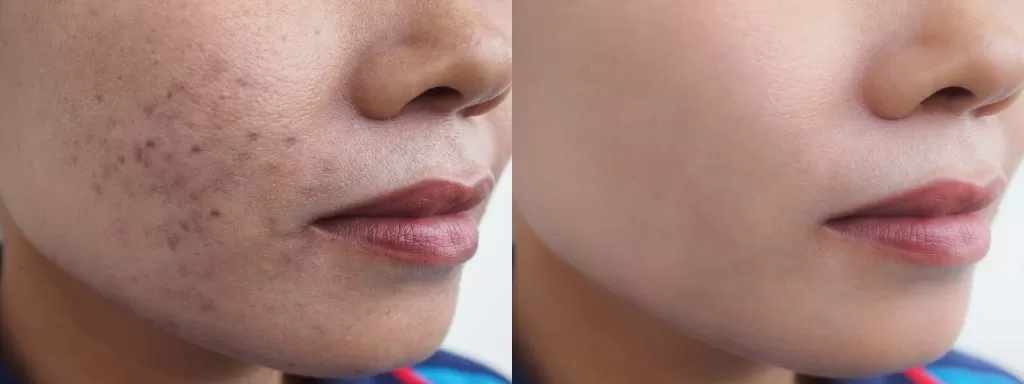
Microneedling Chicken Pox Scars Before And After
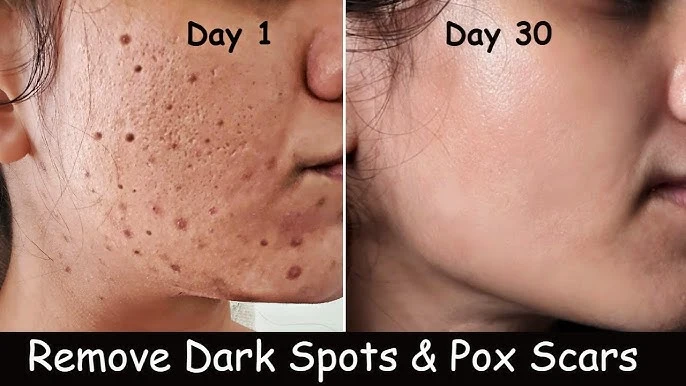
What Do Chicken Pox Scars Look Like?

Chicken pox scars vary in appearance, from small pits to larger depressions or raised bumps, depending on the scar type.
Celebrities With Chicken Pox Scars
Celebrities like Cameron Diaz, Pierce Brosnan, and Keira Knightley have bravely discussed their experiences with chicken pox scars. Their openness has shed light on the commonality of skin imperfections, inspiring others to embrace their journeys toward skin health. By sharing their stories, they’ve helped reduce stigma and encourage effective treatments for scars.
When Do Chicken Pox Scars Go Away?
With proper treatment, chicken pox scars can fade significantly over time. However, complete removal may vary depending on scar severity and individual skin healing.
Chickenpox Scars Prevention Tips
For anyone who is dealing with chickenpox as we speak, or you have someone in the family who is experiencing this painful disease; there are a couple of things that can be done to prevent chickenpox scarring.
Here’s what you can do:
- You should refrain from scratching as much as possible
- In order to avoid unintentional sudden scratches, try wearing oven mitts or mittens
- Dab or pat a soothing lotion onto the blisters. A lotion with cocoa butter and aloe vera is ideal.
- Dab or pat an anti-itch cream, like calamine lotion, directly onto the blisters.
- Take a cool oatmeal bath.
- Try an antihistamine like Benadryl.
Of course, the best way to prevent chickenpox scars is to avoid chickenpox infection. Vaccinate children from chickenpox and older adults from shingles, which is caused by the same virus.
Conclusion
With chickenpox being so excessively common, you may definitely find yourself in a spot where you are looking for the most appropriate, economical, as well as effective cosmetic procedures to remove your chickenpox scars; especially if they are located on your face.
Fortunately for us all, there are several treatments available to get this procedure done successfully – You can reach out to the board-certified aestheticians at Syra Aesthetics and schedule a free consultation to determine which of the available treatments can be a perfect fit for you – Giving you a clear and youthful skin that you desire.
Frequently Asked Questions
Is chickenpox permanent?
How much does chicken pox scar removal cost?
The cost ranges from $300 to $3,000 per session, depending on the treatment type and clinic.
Why are chicken pox scars so deep?
Chickenpox scars are deep due to severe skin inflammation and damage during the infection, leading to depressed scars.
How to remove 10-year-old chicken pox marks?
Treatments like laser therapy, chemical peels, microneedling, and dermabrasion can help remove old chicken pox marks.
How to remove chicken pox holes on the face?
Procedures like laser resurfacing, fillers, and microneedling can reduce the appearance of chickenpox holes on the face.
Can chicken pox scars be removed?
How long do chicken pox marks take to fade?
Chickenpox marks can take several months to a year to fade naturally, but deep scars may require treatment.
How to minimize chicken pox scars?
Use topical treatments, keep the skin moisturized, avoid picking scabs, and consider professional treatments like lasers or microneedling.
How to get rid of acne scars?
To get rid of acne scars, consider treatments like laser therapy, chemical peels, microneedling, dermabrasion, scar revision surgery, or dermal fillers. Topical treatments with retinoids, hyaluronic acid, and alpha hydroxy acids can also help improve skin texture and reduce scarring.
What is scar tissue?
Scar tissue is fibrous tissue that replaces normal skin after an injury. It forms during the healing process and consists of collagen fibers that help strengthen and repair the damaged area, but it often lacks the same texture and functionality as the original skin.
————————————————-
– Disclaimer –
This blog is for informational & educational purposes only and does not intend to substitute any professional medical advice or consultation.
For any symptoms or medical advice, please consult with your physician,
Or Book an appointment with our certified aestheticians at Syra Aesthetics.

-
About The Author
Dr. Syra Hanif M.D.Board Certified Primary Care Physician
Dr. Hanif is the Director of Aesthetic Medicine. She is a board-certified physician in Aesthetic Medicine who specializes in using non-surgical alternatives in order to enhance one's appearance through Botox and fillers.
Read More






